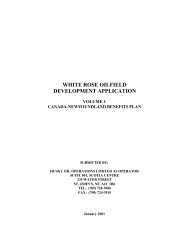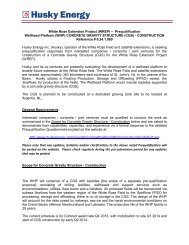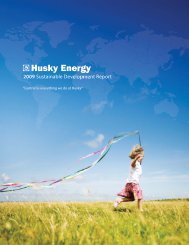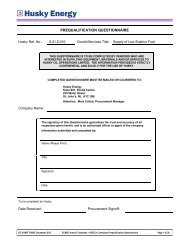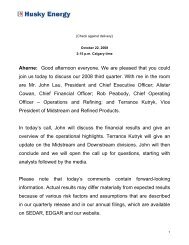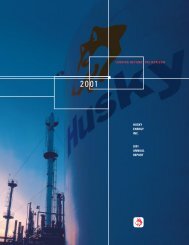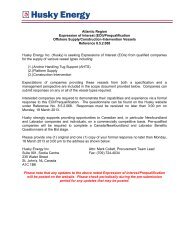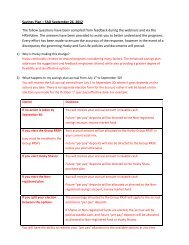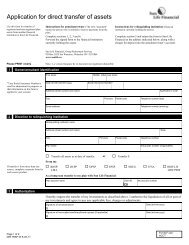white rose oilfield development application - Husky Energy
white rose oilfield development application - Husky Energy
white rose oilfield development application - Husky Energy
- No tags were found...
Create successful ePaper yourself
Turn your PDF publications into a flip-book with our unique Google optimized e-Paper software.
4.1.2 White Rose Structural GeologyThree episodes of rifting affected the White Rose area. During the first rifting phase, thick Osprey/Argosalt beds were deposited. This salt was tectonically mobilized during the second rifting stage formingelongated salt walls parallel with the emerging Central Ridge. Major north-south and northeastsouthwestfaults dissect the sediments deposited above the northerly plunging salt wall, including thesource rocks. The third rifting stage had a pronounced influence on the area as the salt ridge wasdivided by salt withdrawal into a major ridge (Amethyst) and a northerly circular dome in which theoverlying racks have been ruptured (White Rose).Three intersecting fault systems oriented northeast-southwest, north-northwest south-southwest andnorth-south, divide the area. A few major faults (for example, the West Amethyst, Central and Twinfaults), together with a low structural trend oriented north-northeast south-southwest, segment the areainto three pools (Figure 1.2-1). The pools are:• the South Avalon Pool (E-09, L-08, A-17, H-20 and environs), which occupies an area ofapproximately 18 km 2 located east of the Amethyst Ridge and Central Fault; the pool isgeologically complex, and limited by the East Amethyst Central and Twin faults;• the West Avalon Pool (J-49 field and environs) encompasses a 16 km² area and is confined betweenthe West Amethyst, Central and North J-49 faults and the crestal erosional edge; and• the North Avalon Pool (N-30, N-22 and environs) occupies an area of about 10 km²; it is boundedby the Central Fault, White Rose dome erosional edge, Trave Fault and southeastern end of theTrave Syncline.4.2 Reservoir Engineering4.2.1 Reservoir Quality and In Place Resource AssessmentsTwenty-five drill stem tests have been carried out in the White Rose field to assist in evaluatingreservoir production capabilities and determine fluid properties. Results indicate that each of the threeAvalon pools has an oil leg with an associated gas cap and underlying water. The oil-water and gas-oilcontacts are different for each pool, confirming that there are sealing faults in the field. The oil is atypical Jeanne d’Arc Basin waxy crude with an average quality of approximately 30° API. Thereservoirs have fine to very fine sandstone with a relatively low average permeability in the order of100 milliDarcies (mD). In addition, there are several calcite-cemented zones that may hinderproduction.White Rose DA Project Summary • January 2001 Page 48



